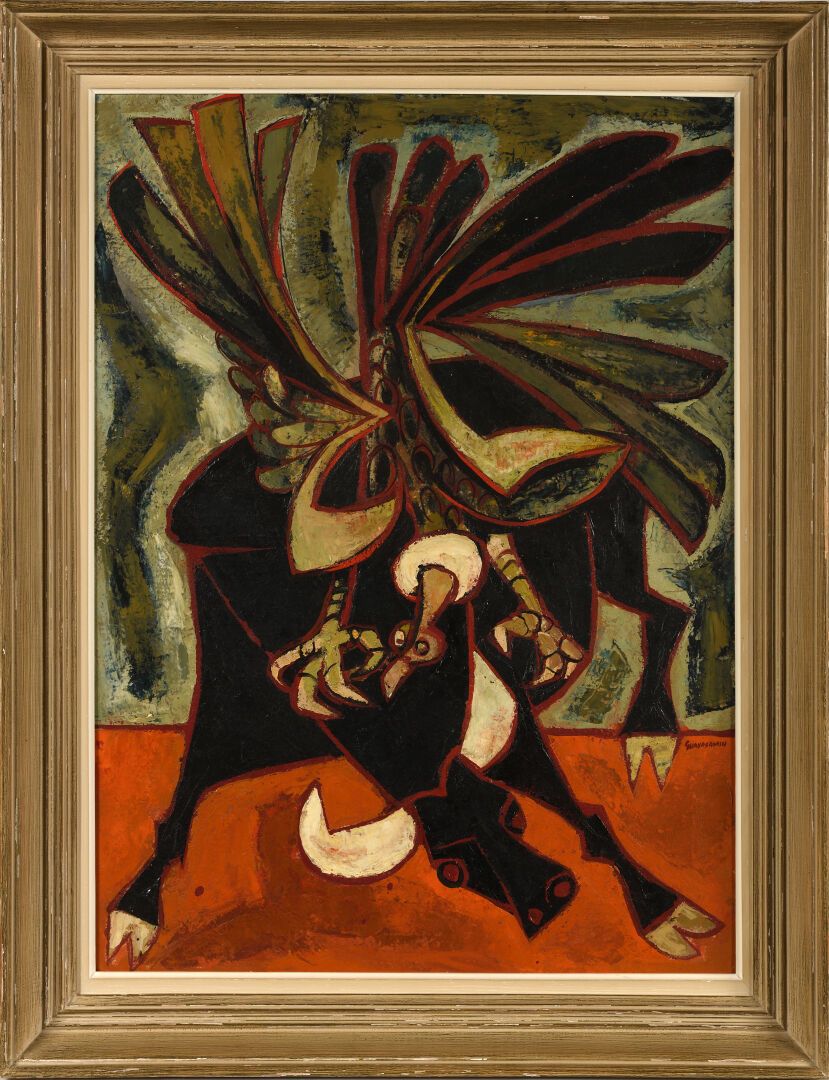Description
Oswaldo GUAYASAMIN (1919-1999). The Bull and the Condor. Oil on panel signed lower right. 76 x 56 cm. Provenance: This painting has the same origin as the portraits. Acquired by Mr. Paul POUMAILLOU directly from the artist, it has remained in the family to this day. Note : This painting restores in a symbolic way the historical drama of the Spanish conquest. The indigenous condor wins over the Spanish bull. It also refers to a Quechuan festival (Ecuadorian indigenous group). This allegorical battle is reenacted every year during the Yawar Fiesta, or Blood Festival, which is held in many Andean villages on July 29, one day after Peru celebrates its independence. A condor, a giant and majestic bird sacred to the Incas, is tied to the back of a bull. It is excited by a matador so that he tries to tear out the eyes of the bull which is thus put to death. Nowadays they do not fight to the death, the condor is freed. In the representation of Guayasamín we see that the animal is writhing with anger and pain. "The juxtaposition of the condor and the bull represents the duality of the Andean world, between the celestial and the terrestrial world," explains anthropologist Juan Ossio; "the conjunction of the condor and the bull, of the sky and the earth is a ritual that recreates the wholeness of the community." This festival, a popular tradition if ever there was one, emanates from the colonial era and developed as a form of resistance to Spanish domination. Its current existence reflects the resilience of indigenous communities and the solidarity of the Andean people. We know that Guayasamín painted several versions of Toro y cóndor. The best known and the most important in format is visible in the "Capilla del Hombre", the museum we mentioned above. Expert : Philippe JAMAULT
288
Oswaldo GUAYASAMIN (1919-1999). The Bull and the Condor. Oil on panel signed lower right. 76 x 56 cm. Provenance: This painting has the same origin as the portraits. Acquired by Mr. Paul POUMAILLOU directly from the artist, it has remained in the family to this day. Note : This painting restores in a symbolic way the historical drama of the Spanish conquest. The indigenous condor wins over the Spanish bull. It also refers to a Quechuan festival (Ecuadorian indigenous group). This allegorical battle is reenacted every year during the Yawar Fiesta, or Blood Festival, which is held in many Andean villages on July 29, one day after Peru celebrates its independence. A condor, a giant and majestic bird sacred to the Incas, is tied to the back of a bull. It is excited by a matador so that he tries to tear out the eyes of the bull which is thus put to death. Nowadays they do not fight to the death, the condor is freed. In the representation of Guayasamín we see that the animal is writhing with anger and pain. "The juxtaposition of the condor and the bull represents the duality of the Andean world, between the celestial and the terrestrial world," explains anthropologist Juan Ossio; "the conjunction of the condor and the bull, of the sky and the earth is a ritual that recreates the wholeness of the community." This festival, a popular tradition if ever there was one, emanates from the colonial era and developed as a form of resistance to Spanish domination. Its current existence reflects the resilience of indigenous communities and the solidarity of the Andean people. We know that Guayasamín painted several versions of Toro y cóndor. The best known and the most important in format is visible in the "Capilla del Hombre", the museum we mentioned above. Expert : Philippe JAMAULT
